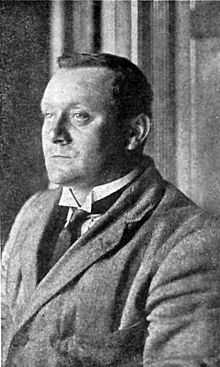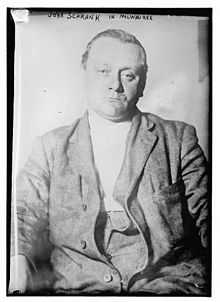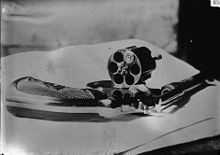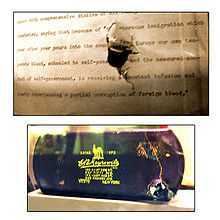John Flammang Schrank

John Flammang Schrank (March 5, 1876 – September 15, 1943) was a resident of New York, best known for his attempt to assassinate former U.S. President Theodore Roosevelt on October 14, 1912 in Milwaukee, Wisconsin.[1]
Biography
Schrank was born in Erding, Bavaria on March 5, 1876.[2] He emigrated to America at the age of 9. His parents died soon after, leaving Schrank to work for his uncle, a New York tavern owner and landlord. Upon their deaths Schrank's aunt and uncle left him these valuable properties from which it was expected he could live a quiet and peaceful life. But Schrank was heartbroken, not just because he had lost his second set of parents, but because his first and only girlfriend Emily Ziegler had died in the General Slocum disaster on New York's East River.[3]
Schrank sold the properties, and drifted around the East Coast for years. He became profoundly religious, and a fluent Bible scholar whose debating skills were well-known around his neighborhood's watering holes and public parks. He wrote spare and vivid poetry. He spent a great deal of time walking around city streets at night. He caused no documented trouble.
Assassination attempt

The 1912 Presidential election campaign was characterised by a serious split in the Republican Party between the conservative wing under President William Howard Taft and the liberal/reform wing under ex-President Theodore Roosevelt. After a bitter confrontation at the Republican Convention, Taft won renomination. Roosevelt led a bolt of his followers, who held a convention and nominated him for President on the ticket of the Progressive Party, nicknamed the "Bull Moose Party." Taft and his supporters attacked Roosevelt for being power-hungry, and seeking to break the tradition that U.S. Presidents only serve up to two terms in office.
On October 14, 1912, while Theodore Roosevelt was campaigning in Milwaukee, Wisconsin, Schrank attempted to assassinate him.



It is unclear when his interest in domestic politics so flared that he would attempt to kill Roosevelt. It is known that he was an opponent of a sitting President's ability to seek a third term in office.[1]
According to documents found on Schrank after the attempted assassination, Schrank had written that he was advised by the ghost of William McKinley in a dream to avenge his death, pointing to a picture of Theodore Roosevelt.
Roosevelt was at the Gilpatrick Hotel at a dinner provided by the hotel's owner, a supporter. The ex-President was scheduled to deliver a speech at the Milwaukee Auditorium. News had circulated that Roosevelt was at the hotel, and Schrank (who had been following Roosevelt from New Orleans to Milwaukee) went to the hotel. The ex-President had finished his meal, and was leaving the hotel to enter his car when Schrank acted.[4]
Schrank did shoot Roosevelt, but the bullet lodged in Roosevelt's chest only after hitting both his steel eyeglass case and a 50-page copy of his speech he was carrying in his jacket. Roosevelt decided the bullet could not have penetrated to his lung because he coughed no blood and, declining suggestions that he go to the hospital, delivered his scheduled speech. He spoke for ninety minutes, but sometimes managed no more than a whisper. His opening comments to the gathered crowd were:[5]
Friends, I shall ask you to be as quiet as possible. I don't know whether you fully understand that I have just been shot; but it takes more than that to kill a Bull Moose. But fortunately I had my manuscript, so you see I was going to make a long speech, and there is a bullet - there is where the bullet went through - and it probably saved me from it going into my heart. The bullet is in me now, so that I cannot make a very long speech, but I will try my best.— Theodore Roosevelt, Address at Milwaukee, Wis., October 14, 1912
Afterwards, doctors determined that he was not seriously wounded and that it would be more dangerous to attempt to remove the bullet than to leave it in his chest. Roosevelt carried it with him until he died.[6] In later years, when asked about the bullet inside him, Roosevelt would say, "I do not mind it any more than if it were in my waistcoat pocket."[7]
Both Taft and Democratic nominee Woodrow Wilson suspended their own campaigning until Roosevelt recovered and resumed his. Roosevelt made only two more speeches in the campaign. Although Roosevelt won more votes and electoral votes than Taft, Wilson bested both of them and won the Presidency.[8]
Schrank maintained, later, that he had nothing against the man himself, and he did not intend to kill 'the citizen Roosevelt', but rather 'Roosevelt, the third-termer.' He claimed to have shot Roosevelt as a warning to other third-termers, and that it was the ghost of William McKinley that told him to perform the act. When Roosevelt died in 1919, Schrank conceded that he was a great American and was sorry to hear of his death.
Doctors soon examined him and reported that he was suffering from 'insane delusions, grandiose in character' and they declared Schrank to be insane.
Schrank was committed to the Central State Mental Hospital in Waupun, Wisconsin, in 1914. He remained there for 29 more years, until his death from natural causes in 1943.[1]
Death
Schrank died on September 15, 1943 of bronchial pneumonia.[1][9] His body was donated to the Medical School at Marquette University (now the Medical College of Wisconsin) for anatomical dissection.
Archive
While John F. Schrank was committed, he wrote a number of letters to the doctor he was consulting at the Mental Hospital, Dr. Adin Sherman. The University of North Carolina at Wilmington possesses twenty of them. The letters are dated between 1914 - 1918. The accession number in the Manuscripts Collection is 148.
References
- ↑ 1.0 1.1 1.2 1.3 "Died". Time magazine. September 27, 1943. Retrieved 2009-01-19.
John Flammang Schrank, 67, Bavarian-born ex-barkeep who shot and wounded Theodore" Roosevelt in Milwaukee in 1912; of bronchial pneumonia; in the Waupun, Wis. hospital where he spent 29 of his 31 mailless, visitorless years in state custody, after being judged a paranoiac. Schrank regarded Teddy's 1912 Bull Moosing as a bid for a third term, decided to shoot him. Schrank's single shot was parried by manuscripts and a spectacle case in T.R.'s pockets. Despite his wound, Teddy made a speech that night, a fortnight later again felt perfectly bully.
- ↑ Oliver E. Remey, et al., The Attempted Assassination of Ex-President Theodore Roosevelt (The Progressive Publishing Company, 1912) p. 192
- ↑ Robert Donovan, The Assassins New York: Popular Library, 1962. p. 104.
- ↑ Donovan, p. 111-114.
- ↑
- ↑ Timeline of Theodore Roosevelt's Life by the Theodore Roosevelt Association at www.theodoreroosevelt.org
- ↑ Donavan, p. 119
- ↑ Donovan,p. 115
- ↑ "Insane Man Had No Visitors in 31 Years in Wisconsin Asylums". New York Times. September 17, 1943. Retrieved 2009-01-19.
John Flammang Schrank, 67, who attempted to kill Theodore Roosevelt in Milwaukee in 1912, died at the Central State Hospital here last night.
Further reading
- Donovan, Robert J., The Assassins, New York, Popular Library, 1962, ch. 101-117: "The First Pillar".
- Gores, Stan, The attempted assassination of Teddy Roosevelt, The State Historical Society of Wisconsin, 1980.
External links
- The Attempted Assassination of ex-President Theodore Roosevelt at Project Gutenberg by Oliver Remey and Henry Cochems and Wheeler Bloodgood
- Theodore Roosevelt (attempted assassination), Wisconsin Dictionary of History, Wisconsin Historical Society
|